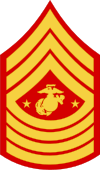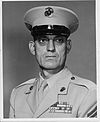Loading AI tools
Senior enlisted member of the U.S. Marine Corps From Wikipedia, the free encyclopedia
The sergeant major of the Marine Corps (officially abbreviated to SMMC)[2][3] is a billet, as well as a unique enlisted grade of rank, and is designated a special paygrade above E-9. The position also has a unique non-commissioned grade of rank insignia, in the United States Marine Corps. The holder of this rank and position is the most senior enlisted marine in the Marine Corps, unless an enlisted marine is serving as the senior enlisted advisor to the chairman, which is the case as of November 3, 2023.
| Sergeant Major of the Marine Corps | |
|---|---|
 Dress uniform insignia of the SMMC | |
| Abbreviation | SMMC |
| Reports to | Commandant of the Marine Corps |
| Seat | Headquarters Marine Corps |
| Appointer | Commandant of the Marine Corps |
| Term length | 4 years |
| Formation | May 23, 1957 |
| First holder | Wilbur Bestwick |
| Unofficial names | Sergeant Major |
| Salary | $9,786.00 per month, regardless of the incumbent's service longevity[1] |
| Website | www |


In the U.S. Marine Corps, sergeant major is the ninth and highest enlisted rank, just above first sergeant, and equal in grade to master gunnery sergeant, although the two have different responsibilities. A sergeant major typically serves as the unit commander's senior enlisted adviser and handles matters of discipline and morale among the enlisted Marines. The Sergeant Major of the Marine Corps is chosen by the commandant of the Marine Corps to serve as his adviser and is the preeminent and highest-ranking enlisted Marine unless an enlisted marine is serving as the senior enlisted advisor to the Chairman. The SMMC holds an order of precedence of a lieutenant general.[4]
Although not officially considered a Sergeant Major of the Marine Corps, when Archibald Sommers was appointed to Sergeant Major on January 1, 1801, it was a solitary post, similar to the modern billet of Sergeant Major of the Marine Corps. In 1833, an act of legislation made the rank of sergeant major permanent for the Marine Corps, and by 1899 five Marines held the rank of sergeant major. This continued until 1946, when the rank was abolished, only to be re-introduced in 1954 as part of the Marine Corps rank structure.[5]
The post of Sergeant Major of the Marine Corps was established in 1957 from the order of Assistant Chief of Staff for Personnel at Headquarters Marine Corps, Brigadier General James P. Berkeley, as the senior enlisted advisor to the commandant of the Marine Corps,[5] the first such post in any of the five branches of the United States Armed Forces.[6] In 1970, the rank insignia of the Sergeant Major of the Marine Corps was authorized (which features three stripes, the Eagle, Globe, and Anchor flanked by two five-point stars in the center, and four rockers) as opposed to the standard Sergeant Major rank insignia (which features three stripes, one five-point star in the center, and four rockers), which was used for the rank from the post's creation in 1957 to 1970. While "Sergeant Major of the Marine Corps" is the full wording of the rank, the verbal address for this is common Sergeant Major.
The commandant of the Marine Corps selects the sergeant major of the Marine Corps and typically serves a four-year term, though his service is at the discretion of the Commandant.[6] Since Sergeant Major Wilbur Bestwick was appointed the first Sergeant Major of the Marine Corps in 1957, 20 different Marines have filled this post.[7]
| No. | Portrait | Name | Term of office | Ref. | ||
|---|---|---|---|---|---|---|
| Took office | Left office | Duration | ||||
| 1 |  |
Wilbur Bestwick
(1911–1972) |
May 23, 1957 | September 1, 1959 | 2 years, 101 days | [8] |
| 2 |  |
Francis D. Rauber
(1901–1991) |
September 1, 1959 | June 29, 1962 | 2 years, 301 days | [9] |
| 3 |  |
Thomas J. McHugh
(1919–2000) |
June 29, 1962 | July 17, 1965 | 3 years, 18 days | [10] |
| 4 |  |
Herbert J. Sweet
(1919–1998) |
July 17, 1965 | August 1, 1969 | 4 years, 15 days | [11] |
| 5 |  |
Joseph W. Dailey
(1917–2007) |
August 1, 1969 | February 1, 1973 | 3 years, 184 days | [12] |
| 6 |  |
Clinton A. Puckett
(1926–2002) |
February 1, 1973 | June 1, 1975 | 2 years, 120 days | [13] |
| 7 |  |
Henry H. Black
(1929–2012) |
June 1, 1975 | April 1, 1977 | 1 year, 304 days | [14] |
| 8 |  |
John R. Massaro
(1930–) |
April 1, 1977 | August 16, 1979 | 2 years, 137 days | [15] |
| 9 |  |
Leland D. Crawford
(1930–1993) |
August 16, 1979 | June 28, 1983 | 3 years, 316 days | [16] |
| 10 |  |
Robert E. Cleary
(1931–2018) |
June 28, 1983 | June 27, 1987 | 3 years, 364 days | [17] |
| 11 |  |
David W. Sommers
(1943–) |
June 27, 1987 | June 28, 1991 | 4 years, 1 day | [18] |
| 12 |  |
Harold G. Overstreet
(1944–) |
June 28, 1991 | June 30, 1995 | 4 years, 2 days | [19] |
| 13 |  |
Lewis G. Lee
(1950–) |
June 30, 1995 | June 29, 1999 | 3 years, 364 days | [20] |
| 14 |  |
Alford L. McMichael
(1952–) |
June 29, 1999 | June 26, 2003 | 3 years, 362 days | [21] |
| 15 |  |
John L. Estrada
(1955–) |
June 26, 2003 | April 25, 2007 | 3 years, 303 days | [22] |
| 16 |  |
Carlton W. Kent
(1957–) |
April 25, 2007 | June 9, 2011 | 4 years, 45 days | [23] |
| 17 |  |
Micheal P. Barrett
(1963–) |
June 9, 2011 | February 20, 2015 | 3 years, 256 days | [24] |
| 18 |  |
Ronald L. Green
(1964–) |
February 20, 2015 | July 26, 2019 | 4 years, 156 days | [25] |
| 19 |  |
Troy E. Black
(1968/1969-) |
July 26, 2019 | August 10, 2023 | 4 years, 15 days | [26] |
| 20 |  |
Carlos A. Ruiz
(1975–) |
August 10, 2023 | Incumbent | 1 year, 75 days | [27] |

Seamless Wikipedia browsing. On steroids.
Every time you click a link to Wikipedia, Wiktionary or Wikiquote in your browser's search results, it will show the modern Wikiwand interface.
Wikiwand extension is a five stars, simple, with minimum permission required to keep your browsing private, safe and transparent.